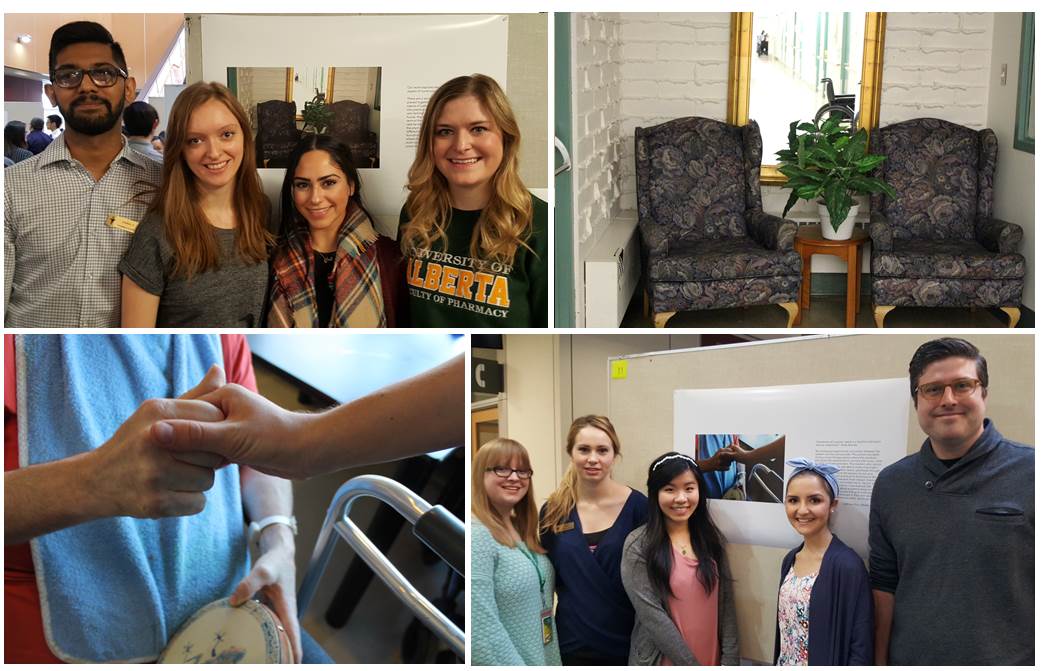
Form top left, (clockwise) students Danial Khan, Chloe Hamel-Martineau, Emelie El-Hage and Jesalyn Clarkson and their submission for the Photovoice project. Their chose a photo (top right) of two chairs in front of a window. The photo explores the relationship between the home aspect of continuing care and the hospital aspect of it. Another group (bottom right), from left, LeAnna Kalvi, Erica McGinn, Michelle Gong and Malak Smoka chose a photo (bottom right) depicting the connection between resident and care provider. Art design instructor Brad Necyk stands next to the group and their photo submission.
Collaboration between faculties can often lead to a new way for students to learn about a familiar topic.
When Cheryl Cox was searching a means for her first-year pharmacy students to experience a different way of reflecting on their volunteer experiences, she turned to art design instructor Brad Necyk.
The two developed a photography project that helped students look at patient-centred care through a different lens - a camera lens.
Both instructors refined their ideas and eventually settled on the idea of the photography assignment since everyone can use their phone and photos are a simple way to express creativity. The assignment culminated with an exhibit, called Photovoice Poster, last week in the Edmonton Clinic Health Academy.
"I wanted a strategy in the course, in addition to our written critical reflection assignments and course evaluations to capture and demonstrate the meaning of the students' experiences and their understanding of person-centred care and citizenship and ultimately how this contributes to their professional development as pharmacists," says Cox, experiential education coordinator for the Faculty of Pharmacy and Pharmaceutical Sciences. "I consulted Brad about arts-based possibilities and Photovoice was the platform we came up with."
"Cheryl and I thought the photo project would be a great way for pharmacy students to use another part of their brain to reflect visually about their volunteer experiences in patient care facilities," says Necyk, a sessional instructor in the Art & Design Program in the Faculty of Arts.
"Pharm 300 is a service learning course where students are involved in volunteer programs in a variety of settings including long term care, rehabilitation, family support agencies and programs for disabled adults," says Cox.
Cox says students use the skills learned in communication courses and are actively involved with clients and residents exploring the meaning and value of person-centred care based on their experiences.
"They also draw connections to the importance of patient relationships in their future practice," she says. "Students also consider their professional identity through a model of citizenship and are encouraged to use a critical lens to recognize and question inequities of care in our health care system."
Student teammates Chloé Hamel-Martineau, Danial Khan, Emelie El-Hage and Jesalyn Clarkson chose a photo of two chairs in front of a window. The group chose a photo that explores the relationship between the home aspect of continuing care and the hospital aspect of it.
Their submission read: There are a series of objects in this photo, that, when placed together, paint a conflicting image about the nature of patient care that the institution wishes to put into practice. Although the classic furniture evokes a very familiar style, one typical of a grandparent's house, the less prevalent institutional furnishings remind the viewer that this is, indeed, a long-term care facility. The two patterned chairs, the side table, the plant and the gold-rimmed mirror are relics of a different time and contrast the institutionalized furnishings found in the image: the tiled floor, the wheelchair, the plastered wall and large door with the push-open bar. This image begs the question: can a place be a home, if it is only somewhat like it?
"We took about 30 photos in the facility we were volunteering in," says Hamel-Martineau of her group's experience. "We chose a particular photo because it depicted the conflicting realities of living in a care facility."
"The real interesting part of the project was that we could only take photos of the facility, inanimate objects and relay these complex ideas and that challenge made it a very interesting project," says Khan.
Necyk prepared the students before the assignment with some technical training on how to compose a photo and how to take a photo. He also met one-on-one with each group and discussed their experiences in clinical settings.
"We did some technical training and I think it paid off," says Necyk. "As an artist, I was very impressed with the photos and I am happy with how it turned out. I even learned a lot about pharmacy from the students by having those one-on-one conversations."
Necyk believes everyone has the potential to be creative in some way.
"Everyone has a creative side to themselves, even if it's an Instagram account," says Necyk. "That Instagram account is a way to express your creativity through photos."
Cox says her students valued the chance to use a different medium for learning and there was a lot of experience sharing during the photo exhibition.
"Students were interested in the interpretations of the chosen photos of other groups and were excited and proud to share their work with each other," says Cox.
Cox says she plans to use the photos as appreciation gifts for our community partners, art work for the faculty's professional practice lab and faculty and for presentations at future pharmacy conferences.